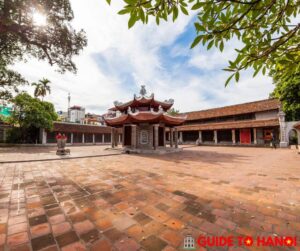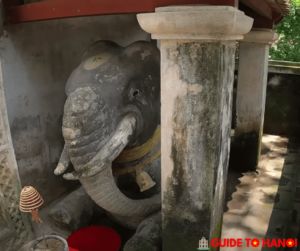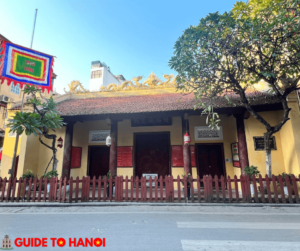Kim Liên Temple
Nestled in Nghi Tam village, Kim Lien Pagoda is a testament to Vietnam’s ancient architectural wonders.
The pagoda’s history is as rich as its intricate wooden structures, offering visitors a glimpse into the country’s royal past.
Origins and Transformation
Originally a palace named Tu Hoa, built during the Ly Dynasty, the site became a temple dedicated to Princess Tu Hoa.
Over the centuries, it underwent several name changes, reflecting the influences of different dynasties.
A Symbol of Resilience
Kim Lien Pagoda has maintained its majestic appearance despite various renovations and repairs.
Its three-entrance gate, adorned with exquisite wooden carvings, welcomes visitors with mystery and grandeur.
Architectural Marvel
The pagoda’s layout follows a symmetrical axis, typical of royal structures, with three parallel pagodas forming a unique “three” shape. Intricate carvings of dragons, flowers, and leaves adorn the wooden surfaces, adding to their regal charm.
Roof of Elegance
The tiled roof, resembling stacked matches, is crowned with dragon-shaped swords, adding a touch of mythical allure.
The base of the columns rests on a rock, intricately carved into lotus flowers, symbolizing purity and enlightenment.
Treasures Within
Ancient statues dating back to the 18th and 19th centuries are on display inside the pagoda.
The Buddha statues, including the Three Worlds set and the Amitabha statue, showcase exquisite craftsmanship and spiritual significance.
Preserving History
Despite its age, Kim Lien Pagoda still houses an ancient stele dating back to 1445, the oldest in Hanoi.
Although time has worn away some inscriptions, the stele remains a testament to the pagoda’s enduring legacy.
Visit Kim Lien Pagoda
Experience the beauty and history of Kim Lien Pagoda on your next trip to Hanoi.
Immerse yourself in its ancient allure and discover the stories hidden within its walls.

| Kim Lien Pagoda | |
|---|---|
| Location | Nghi Tam village, Tay Ho district, Hanoi |
| Origins | Originally a palace named Tu Hoa, built during the Ly Dynasty |
| Architectural Style | Royal appearance, influenced by its origin as a palace |
| Layout | Symmetrical axis with three parallel pagodas in the shape of “three” (三) |
| Roof | Tiled with dragon-shaped swords resting on rock carved into lotus flowers |
| Significance | One of the ten most unique ancient architectural relics in Vietnam |
| Statues | 18th-19th century sculpture style, including Buddha statues and statues of King Tinh Do Trinh Sam |
| Stele | The oldest stele in Hanoi, dating back to 1445 |
Address:
- Nghi Tàm, Quảng An, Tây Hồ, Hà Nội
Opening Hours:
- Daily: 8:00–17:00




